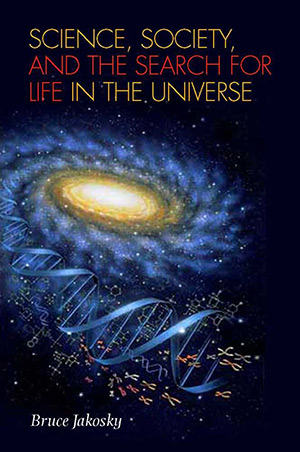Category: Non-Fiction
Reviewed by: Masse Bloomfield
Title: Science, Society and the Search for Life in the Universe
Author: Bruce Jakosky
NSS Amazon link for this book
Format: Paperback
Pages: 150
Publisher: University of Arizona Press
Date: October, 2006
Retail Price: $17.95
ISBN: 0816526133
Science, Society and the Search for Life in the Universe is a book for the space philosopher. The author asks hard questions such as “What is life?” and “Is there life elsewhere?”
Since this book attempts to understand humans and their place in the universe, a difficult thing to do, some of the language in the book can be a little difficult as well. I found the book quite challenging, especially because the author is dealing with the basic understanding of God, the universe and life in the universe.
The headings for the chapters are:
Introduction: Astrobiology, Science and Society
1. Is There Life Elsewhere?
2. What Is Life?
3. Is Astrobiology Science?
4. Astrobiology as a Historical Science
5. Why Do We Do Science?
6. Astrobiology, Science and Religion
7. The Two Cultures of Astrobiology
The book starts off with a description of astrobiology. The author, Bruce Jakosky, is an astrobiologist. He describes astrobiology as “a discipline that involves trying to understand the origin, evolution and distribution of life within the universe.” He notes that there is a lack of data points to define our universe. How can we really tell what happened if/when the universe was created in the Big Bang? The author uses the term ‘historical science’ to define those areas where data is sparse such as the evolution of life on Earth which has few data points and thus has to be a historical science. The search for life on Mars has little data also, so that inferences are necessary to try to understand its life origins.
I expected Jakosky to mention Fermi’s Paradox: “Where are they?” Jakosky skirted the popular question concerning the contradiction of the high probability of the existence of extraterrestrial civilizations and the lack of evidence of contact with them.
I also expected a section on society or sociology. I believe that the author was mostly concerned about the reactions of society toward space, space activities, and scientific activity such as astrobiology. The author did look at the contradiction between the public’s fascination with space, and the meager dialog that exists between those within the scientific community and those outside it. Also the author felt that the NASA public relations campaign has become an impassioned political wrangling for its government
funding.
I think that the last sentence of the book sums up what the author felt about his arguments. He wrote: “Understanding the universe and the potential and actual distribution of life within it will illuminate our own existence here on Earth and help us comprehend our own species, our own society and our own individual lives.”
The book should be read by those space enthusiasts who are really involved with all the parameters of life and ideas about space. It is not for the space dilettante.
© 2007 Masse Bloomfield
NSS Featured Review for April 2007
Please use the NSS Amazon Link for all your book and other purchases. It helps NSS and does not cost you a cent! Bookmark this link for ALL your Amazon shopping!



















